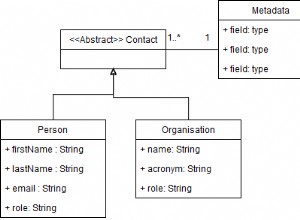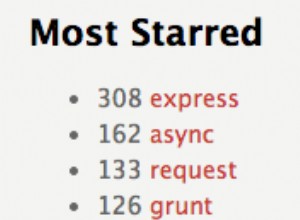Ich habe ein Mongoose-Schema für alle erforderlichen Details erstellt. Sie können sich dabei helfen lassen. Ich habe Ihre Anforderungen ein wenig analysiert und Modelle für viele Schemas hinzugefügt, erste Frage Schema, als Modell exportiert
import { Schema } from 'mongoose';
import { AnswerOptionSchema } from './answer-option-schema';
const mongoose = require('mongoose');
export const QuestionSchema: Schema = new Schema({
question: {
type: String,
minlength: 10,
maxlength: 1000,
},
answerOptions: {
type: [AnswerOptionSchema],
default: undefined,
validate: {
validator: function(value: any) {
return value && value.length === 4;
},
message: 'Answer options should be 4.'
}
}
}, {
timestamps: true
});
export const Question = mongoose.model('Question', QuestionSchema);
und hier im QuestionSchema , habe ich ein AnswerOptionSchema eingebettet als
import { Schema } from 'mongoose';
export const AnswerOptionSchema: Schema = new Schema({
optionNumber: {
type: Number
},
answerBody: {
type: String,
minlength: 1,
maxlength: 200,
},
isCorrectAnswer: { // you can store the correct answer with question id in another model.
type: Boolean,
default: false
}
}, {
_id: false
});
Mit Hilfe dieser Schemas habe ich ein QuestionSetSchema erstellt um eine Reihe von Frageschemata hinzuzufügen als
import { Schema } from "mongoose";
import { QuestionSchema } from "./question-schema";
const mongoose = require('mongoose');
export const QuestionSetSchema: Schema = new Schema({
questionSet: {
type: [QuestionSchema],
validate: {
validator: function(value: any) {
return value.length === 12;
},
message: 'Question set must be 12.'
}
},
}, {
timestamps: true
});
export const QuestionSet = mongoose.model('QuestionSet', QuestionSetSchema);
Jetzt vorbereitet mit der Frage, den Antwortoptionen und dem Satz, müssen Sie jetzt das Kandidatenschema entwerfen,
import { Schema } from "mongoose";
const mongoose = require('mongoose');
export const CandidateSchema: Schema = new Schema({
name: String,
email: String, // you can store other candidate related information here.
totalAttempt: {
type: Number,
default: 0,
validate: {
validator: function(value: number) {
return value === 3;
},
message: 'You have already done three attempts.'
}
},
candidateQuestionAnswers: {
type: [Schema.Types.ObjectId],
ref: 'CandidateQuesAnswer'
}
}, {
timestamps: true
});
export const Candidate = mongoose.model('Candidate', CandidateSchema);
Sie werden feststellen, dass ich hier auch den Gesamtversuch des Kandidaten und die Antworten für jeden von ihm in der CandidateQuesAnswer gegebenen Satz berechne Modell. Dieses Modell hat die Struktur wie
import { Schema } from "mongoose";
export const CandidateQuesAnswerSchema = new Schema({
candidate: {
type: Schema.Types.ObjectId,
ref: 'Candidate'
},
questionSet: {
type: Schema.Types.ObjectId,
ref: 'QuestionSet'
},
questionAnswers: {
type: [Number] // You can add answer schema
},
totalScore: {
type: Number
},
isPassed: {
type: Boolean,
default: false
}
}, {
timestamps: true
});
CandidateQuesAnswerSchema.pre('save', function updateTotalScore(next) {
// update total score of the candidate here based on the correct questionAnswers and
// questionSet.
next();
});
CandidateQuesAnswerSchema.pre('save', function updateIsPassed(next) {
// update the isPassed based on the totalScore obtained by the candidate.
next();
});
export const CandidateQuesAnswer = mongoose.model('CandidateAnswer', CandidateQuesAnswerSchema);
Wo ich pre save verwendet habe Haken, die von mongoose bereitgestellt werden , bevor Sie das Dokument speichern und die Werte berechnen, um den Kandidaten als bestanden oder nicht bestanden zu erklären.




